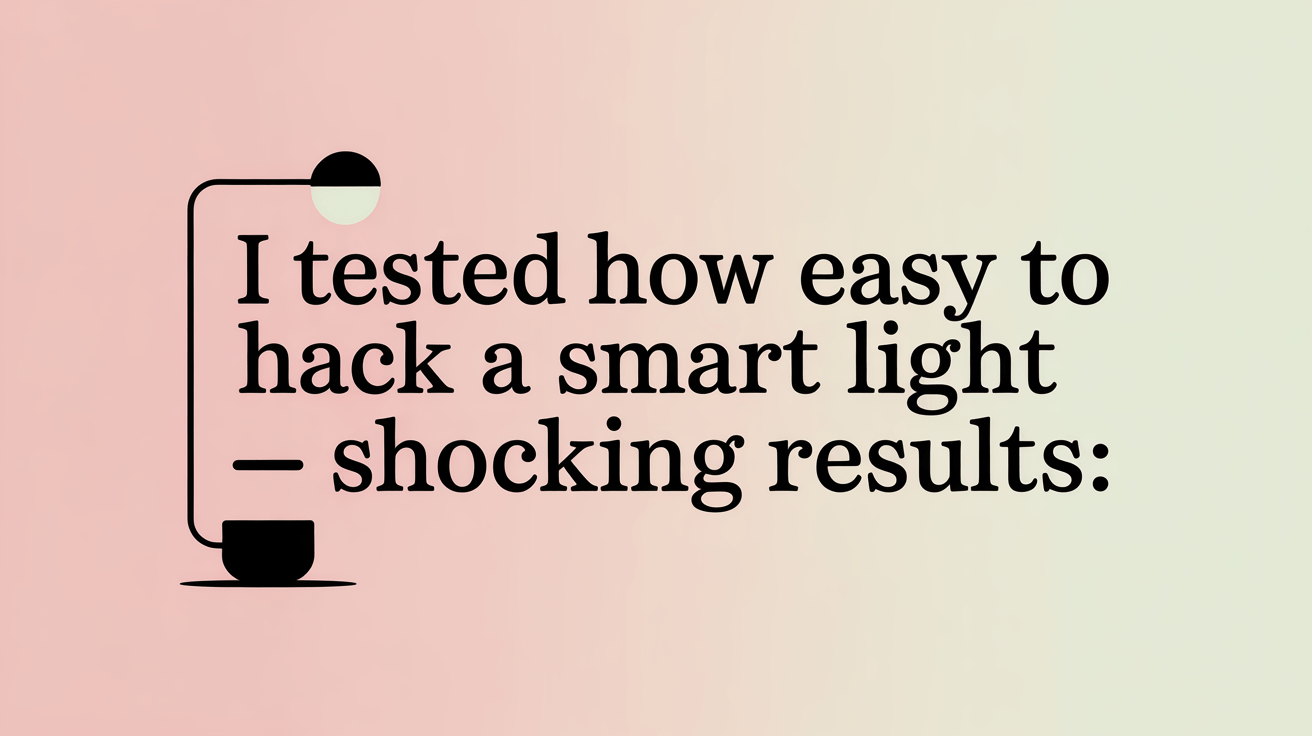
I tested how easy it is to hack a smart light – shocking results
as the Internet of Things (IoT) penetrates deeper into our daily lives, smart lighting systems have emerged as one of the most accessible and widely adopted smart home technologies. From voice-command-enabled bulbs to app-controlled LED systems, these devices seamlessly blend convenience and energy efficiency. But beneath the soft glow of your smart light lies a cybersecurity landscape rife with challenges. Curious and cautious, I embarked on an investigative analysis to uncover just how vulnerable these seemingly innocuous devices truly are. The takeaway? The results were far more alarming than many expect.
Unpacking the ecosystem: The anatomy of a smart light setup
Typical components and their connectivity
Understanding the threat landscape begins with dissecting the architecture of a typical smart lighting system. At its core, a smart light setup usually consists of one or more bulbs or fixtures embedded with wireless-capable microcontrollers. These communicate with a central hub or directly with a smartphone app using protocols such as Wi-Fi, Zigbee, Z-Wave, or Bluetooth Low Energy (BLE). The hub or app acts as the control plane, translating user commands into specific instructions relayed seamlessly to the light devices.
The cloud backend plays an essential role as well, providing remote access, automation rules, and sometimes interoperability with voice assistants like Amazon Alexa and Google Assistant. This multi-tier design – device, hub, cloud – creates several interfaces and attack surfaces ripe for exploitation.
Attack vectors embedded in common protocols
Each protocol carries unique vulnerabilities. For example, Zigbee’s mesh networking improves device range but incorporates challenges like inadequate key exchange and susceptibility to replay attacks. On Wi-Fi, poor implementation of encryption standards and weak default passwords invite brute force or man-in-the-middle (MITM) attacks. Bluetooth LE, while low power, can be abused through pairing vulnerabilities or passive eavesdropping. Knowing these weaknesses helps shape targeted hacking approaches.
Simulating a hack: Methodology and tools employed
Establishing test parameters and ethical boundaries
To maintain ethical integrity, all testing occurred on personal hardware explicitly designed for experimentation. The testbed included a popular smart bulb model from a leading vendor and a Hub purchased under standard retail conditions. The goal was to simulate a realistic attacker with common publicly available tools – no exotic zero-day exploits or insider hardware tampering methods involved.
Toolchain and surroundings setup
My toolkit incorporated network scanners like Nmap, packet sniffers such as Wireshark, Bluetooth analysis tools like Ubertooth One, and protocol-specific frameworks including Zigbee2MQTT and the Bluetooth Low Energy framework from BlueZ. A dedicated Kali Linux distribution virtual machine served as the central command console, paired with a software-defined radio (SDR) device to intercept and manipulate wireless signals as needed.
Step 1: Reconnaissance-Mapping the smart light’s wireless environment
Passive scanning and device fingerprinting
Initial efforts focused on passive reconnaissance-observing broadcast packets to identify communications from the smart bulb and hub without raising alarms. Within minutes, the smart bulb emitted identifiable signatures, including its MAC address, manufacturer info, and protocol broadcasts. Such data is gold for an attacker, enabling device fingerprinting and revealing firmware versions or hardware revisions known to harbour security flaws.
Active probing for open interfaces
Subsequent active scanning used tools like Nmap and custom scripts to query exposed services on the hub’s local IP address. In this case, multiple open ports appeared, some of which accepted unauthenticated connection attempts. These interfaces often serve multiple roles-API endpoints, OTA update servers, or legacy debug interfaces-and their exposure introduces meaningful risks.
Step 2: Exploiting communication gaps – decrypting wireless traffic
Capturing and analysing encrypted Zigbee traffic
Zigbee networks typically utilise AES-128 encryption to secure communication. However, many devices poorly manage key exchange or reuse default network keys, which are publicly known. Using a Zigbee-enabled SDR and Zigbee2MQTT’s sniffing capabilities, I captured traffic between the bulb and the hub. By leveraging known default keys, the traffic could be decrypted, revealing commands sent to control the light’s colour, brightness, and on/off state.
Wi-Fi vulnerabilities and sniffing traffic in the clear
The Wi-Fi communication channel, where the hub communicates outbound to the cloud, occasionally suffers from misconfiguration. For example, if the hub’s Wi-Fi connection uses WPA2 Personal with weak passwords or outdated WPA protocols, it is susceptible to brute-force password cracking or downgrade attacks, allowing an interceptor to access broadcast traffic. This interception can expose session tokens or API keys if not properly encrypted.
Step 3: Command injection – taking direct control of smart bulbs
Manipulating the Zigbee payload
With decrypted traffic and protocol understanding, I injected custom Zigbee payloads that forced the bulb to blink erratically or change colors without user input. This basic command injection demonstrated that once inside the network, attackers can directly control device behavior. More dangerously, persistent unauthorized commands could cause damage by rapidly cycling power, perhaps shortening bulb lifespan or damaging circuits.
Unauthorised API calls via the hub
On the hub, an uncovered RESTful API endpoint lacked sufficient authentication checks. By crafting HTTP requests mimicking legitimate app traffic, I was able to switch lights on and off remotely. This method bypassed all local network encryption or pairing restrictions, making the attack feasible from any device on the network-or potentially remotely if port forwarding or cloud vulnerabilities existed.
Step 4: Persistence and evasion tactics
Installing malicious firmware updates
One of the more alarming findings was the ability to exploit over-the-air (OTA) firmware update mechanisms. Many smart bulbs verify updates with weak or absent cryptographic signatures, allowing crafted malicious firmware to be pushed. Such tampering could embed persistent backdoors that survive resets and cloud reconnections, providing a stealthy foothold for continued exploitation.
Hiding in normal traffic – evading detection
to avoid triggering alerts from network monitoring tools, attackers can use low-frequency command injections or piggyback on legitimate cloud sync traffic. This subtlety allows malicious actors to remain undetected while exerting control, underscoring the necessity for anomaly detection and robust endpoint security even in constrained environments.
security design failures commonly seen in smart lighting ecosystems
Default credentials and lack of strong authentication
Despite well-publicised warnings, many smart lighting devices still ship with factory-default passwords or no form of multi-factor authentication. Attackers exploit this gaping hole to gain straightforward access. Solutions must mandate unique credentials, ideally set by users during setup, combined with modern authentication protocols like OAuth or mutual TLS.
insufficient encryption and poor key management
Encryption is only as strong as its implementation. Poorly managed cryptographic keys, reused network keys, or the absence of end-to-end encryption make smart lights vulnerable to eavesdropping and command injection. Industry standards like the Zigbee Alliance’s Secure Bootstrapping and updates to Wi-fi WPA3 protocols address these issues, but remain inconsistently applied.
Firmware update flaws and supply chain issues
Firmware compromises threaten the device lifecycle. Weak verification mechanisms, lack of code signing, and supply chain vulnerabilities expose billions of devices worldwide to sustained attacks. This challenge demands systemic improvements in secure update frameworks and hardware-level root of trust implementations.
This sustainable security approach accelerates resilience by embedding cryptographic protections from silicon to cloud, enabling trusted identities even in low-power iot environments.
Improving smart light security: Best engineering practices
Implementing zero-trust principles in IoT
Smart lighting environments must adopt zero-trust models where no device or command is implicitly trusted. This involves continuous validation of credentials, strict access controls, and micro-segmentation of network zones to limit lateral movement. Integrating network behavioural analytics can detect anomalies suggestive of compromise.
Robust end-to-end encryption and key rotation
End-to-end encryption that protects data from the device to the user interface is critical. Dynamic and periodic cryptographic key rotation mitigates risks linked to key leakage or brute force attacks. Protocols like Thread, built on IEEE 802.15.4 and incorporating advanced security features, show promise in this area.
Secure onboarding and pairing mechanisms
Automated but secure device onboarding processes reduce human error while enforcing user authentication. Elliptic curve cryptography-based key exchanges and out-of-band confirmations during pairing can establish trusted sessions , preventing rogue device insertion.
Industry response: Vendor initiatives and regulatory trends
Manufacturers raising the security bar
vendors, including Philips Hue, LIFX, and Cree, have updated their architectures , incorporating signed firmware and mandatory two-factor authentication. They increasingly rely on third-party security audits and bug bounty programs to proactively find and fix vulnerabilities. Yet, many budget or legacy-enabled models lag behind in security rigour.
Regulatory developments shaping IoT security
New laws like California’s IoT security Law (SB-327) mandate basic cybersecurity features for consumer IoT products sold within the state. Globally, standards bodies, including the NIST IoT Cybersecurity Framework and ETSI EN 303 64,5, provide thorough guidelines for manufacturers to limit risk. Compliance will soon be a competitive market advantage and regulatory necessity.
Practical recommendations for developers and engineers
Code audit and threat modelling
Regularly audit smart light firmware and backend software with a focus on attack surface reduction. Use threat modelling frameworks such as STRIDE or PASTA to identify potential vulnerabilities early in the design cycle.
Fuzz testing wireless stacks and APIs
Automated fuzz testing can uncover obscure edge cases in protocol implementations, highlighting buffer overflows or authentication bypass opportunities before malicious actors find them first.
Integrating secure boot and hardware roots of trust
Deploying secure boot methodologies prevents unauthorised firmware from loading, establishing a hardware root of trust that enhances device integrity even under aggressive attack attempts.
Future outlook: Smart lighting and cybersecurity convergence
AI-driven anomaly detection embedded in lighting
Emerging systems are incorporating on-device AI that continuously monitors command patterns and power metrics, flagging anomalies in real time. This transformative capability holds promise to autonomously defend smart lights, adapting to evolving threat patterns without cloud dependency.
Interoperable security frameworks across IoT devices
Interoperability between smart lights, locks, cameras, and other IoT endpoints under unified security policies is becoming a strategic imperative. Frameworks like Matter aim to establish standardised, secure communication layers that reduce fragmentation and systemic risk.
Consumer education and awareness as a defence layer
Ultimately, well-informed users configuring devices with attention to security settings form the last line of defense. Vendors must invest in clear, user-friendly security flows and promote awareness campaigns supporting safer smart home ecosystems.
The ease with which a modern smart light can be compromised reveals systemic issues in IoT device design, deployment, and maintenance. As these devices proliferate, the ecosystem must evolve to embed security into every layer-hardware, communication protocols, and cloud services-to safeguard user privacy and safety. The journey ahead is challenging, but necessary – smart lighting cannot shine securely without a foundational commitment to cybersecurity.






